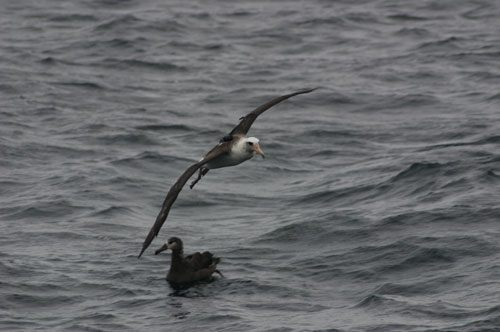Ramunas Zydelis (Center for Marine Conservation, Nicholas School of the Environment, Duke University Marine Laboratory, USA) and colleagues, publishing on-line this year in the Proceedings of the Royal Society Biological Sciences, have utilized telemetry data obtained from Laysan Phoebastria immutabilis and Black-footed P. nigripes Albatrosses to ascertain the degree of overlap with Hawaiian fisheries.
The paper's abstract follows:
"Fisheries bycatch is a recognized threat to marine megafauna. Addressing bycatch of pelagic species however is challenging owing to the dynamic nature of marine environments and vagility of these organisms. In order to assess the potential for species to overlap with fisheries, we propose applying dynamic habitat models to determine relative probabilities of species occurrence for specific oceanographic conditions. We demonstrate this approach by modelling habitats for Laysan (Phoebastria immutabilis) and black-footed albatrosses (Phoebastria nigripes) using telemetry data and relating their occurrence probabilities to observations of Hawaii-based longline fisheries in 1997-2000. We found that modelled habitat preference probabilities of black-footed albatrosses were high within some areas of the fishing range of the Hawaiian fleet and such preferences were important in explaining bycatch occurrence. Conversely, modelled habitats of Laysan albatrosses overlapped little with Hawaii-based longline fisheries and did little to explain the bycatch of this species. Estimated patterns of albatross habitat overlap with the Hawaiian fleet corresponded to bycatch observations: black-footed albatrosses were more frequently caught in this fishery despite being 10 times less abundant than Laysan albatrosses. This case study demonstrates that dynamic habitat models based on telemetry data may help to project interactions with pelagic animals relative to environmental features and that such an approach can serve as a tool to guide conservation and management decisions."
Reference:
Zydelis, R., Lewison, R.L., Shaffer, S.A., Moore, J.E., Boustany, A.M., Roberts, J.J., Sims, M., Dunn, D.C., Best, B.D., Tremblay, Y., Kappes, M.A., Halpin, P.A., Costa, D.P. & Crowder, L.B. 2011. Dynamic habitat models: using telemetry data to project fisheries bycatch. Proceedings of the Royal Society Biological Sciences doi: 10.1098/rspb.2011.0330.

John Cooper, ACAP Information Officer, 14 July 2011

 Français
Français  English
English  Español
Español